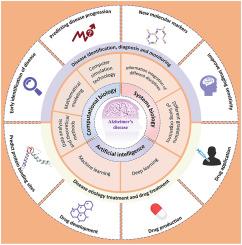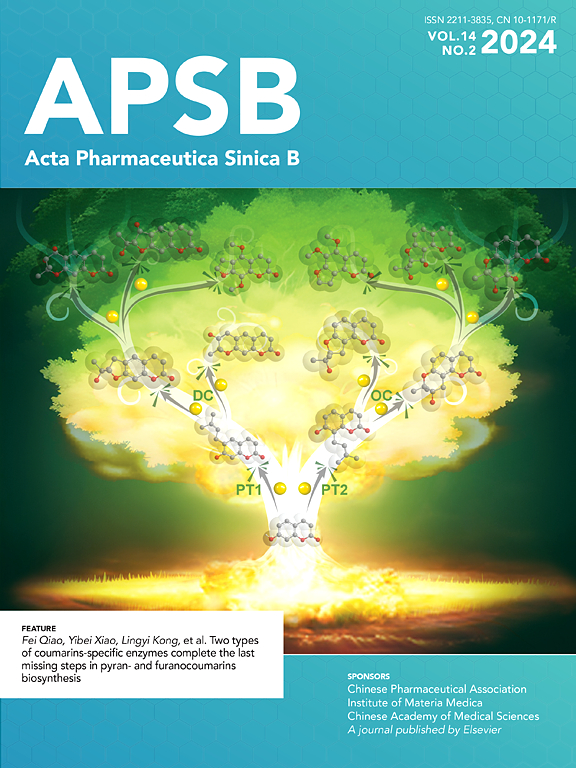由人工智能、计算和系统生物学指导的阿尔茨海默病转化研究的新见解
IF 14.6
1区 医学
Q1 PHARMACOLOGY & PHARMACY
引用次数: 0
摘要
阿尔茨海默病(AD)以认知和功能退化为特征,病理特征为实质神经元胞外间隙淀粉样蛋白(Aβ)聚集,细胞内由tau蛋白过度磷酸化形成的神经原纤维缠结。尽管进行了深入的研究,但目前针对减少a β产生、促进其清除和抑制tau蛋白磷酸化和聚集的治疗方法尚未达到临床预期,这对阿尔茨海默病药物的开发构成了重大障碍。近年来,人工智能(AI)、计算生物学(CB)和系统生物学(SB)已成为AD研究中有前途的方法。他们分析广泛和不同数据集的能力有助于识别复杂的模式,从而丰富我们对阿尔茨海默病病理的理解。本文全面探讨了AI、CB和SB在AD诊断中的应用,包括使用成像组学进行早期检测、药物发现方法(如lecanemab)和补充疗法(如光疗)。这一综述为进一步研究翻译性AD提供了新的视角和潜在的途径。本文章由计算机程序翻译,如有差异,请以英文原文为准。

New insights into translational research in Alzheimer's disease guided by artificial intelligence, computational and systems biology
Alzheimer's disease (AD) is characterized by cognitive and functional deterioration, with pathological features such as amyloid-beta (Aβ) aggregates in the extracellular spaces of parenchymal neurons and intracellular neurofibrillary tangles formed by the hyperphosphorylation of tau protein. Despite a thorough investigation, current treatments targeting the reduction of Aβ production, promotion of its clearance, and inhibition of tau protein phosphorylation and aggregation have not met clinical expectations, posing a substantial obstacle in the development of drugs for AD. Recently, artificial intelligence (AI), computational biology (CB), and systems biology (SB) have emerged as promising methodologies in AD research. Their capacity to analyze extensive and varied datasets facilitates the identification of intricate patterns, thereby enriching our comprehension of AD pathology. This paper provides a comprehensive examination of the utilization of AI, CB, and SB in the diagnosis of AD, including the use of imaging omics for early detection, drug discovery methods such as lecanemab, and complementary therapies like phototherapy. This review offers novel perspectives and potential avenues for further research in the realm of translational AD studies.
求助全文
通过发布文献求助,成功后即可免费获取论文全文。
去求助
来源期刊

Acta Pharmaceutica Sinica. B
Pharmacology, Toxicology and Pharmaceutics-General Pharmacology, Toxicology and Pharmaceutics
CiteScore
22.40
自引率
5.50%
发文量
1051
审稿时长
19 weeks
期刊介绍:
The Journal of the Institute of Materia Medica, Chinese Academy of Medical Sciences, and the Chinese Pharmaceutical Association oversees the peer review process for Acta Pharmaceutica Sinica. B (APSB).
Published monthly in English, APSB is dedicated to disseminating significant original research articles, rapid communications, and high-quality reviews that highlight recent advances across various pharmaceutical sciences domains. These encompass pharmacology, pharmaceutics, medicinal chemistry, natural products, pharmacognosy, pharmaceutical analysis, and pharmacokinetics.
A part of the Acta Pharmaceutica Sinica series, established in 1953 and indexed in prominent databases like Chemical Abstracts, Index Medicus, SciFinder Scholar, Biological Abstracts, International Pharmaceutical Abstracts, Cambridge Scientific Abstracts, and Current Bibliography on Science and Technology, APSB is sponsored by the Institute of Materia Medica, Chinese Academy of Medical Sciences, and the Chinese Pharmaceutical Association. Its production and hosting are facilitated by Elsevier B.V. This collaborative effort ensures APSB's commitment to delivering valuable contributions to the pharmaceutical sciences community.
 求助内容:
求助内容: 应助结果提醒方式:
应助结果提醒方式:


